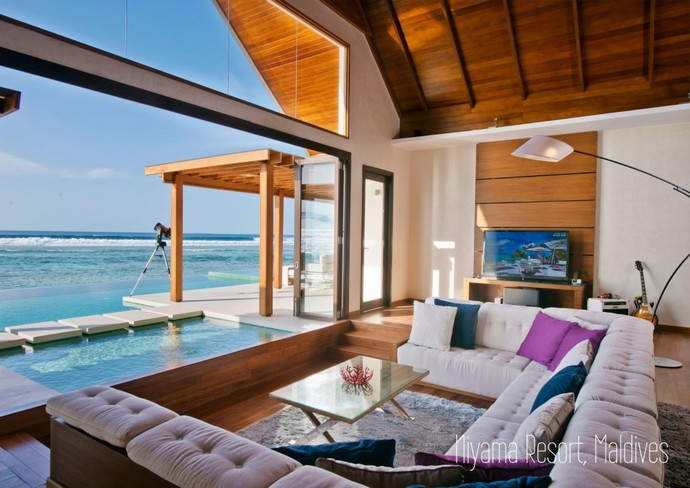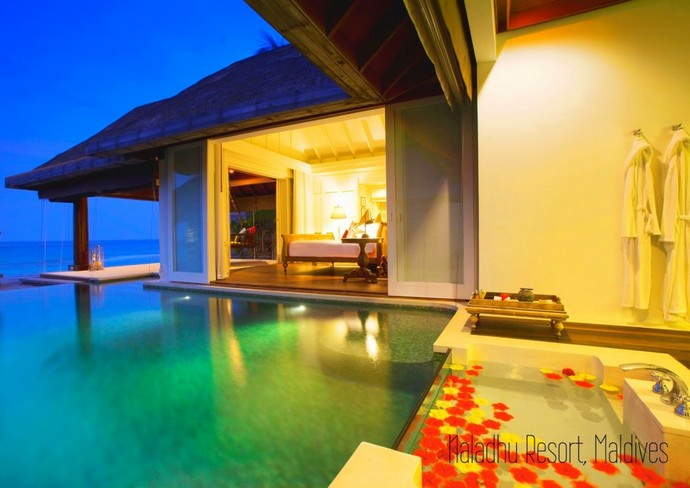The Maldives has been a draw for tourists from the world over, particularly more for those who crave crystal clear, white sand beaches and the unending summer sun.
It has come to be known as the “it” spot for honeymoons and luxury holidays, as images of indulgent villas propped by stilts above pellucid waters, with a view of the vast Indian Ocean are widely used in promotional brochures. The Maldives is not just a stretch of islands surrounded by the sea, but also a place of culture and high environmental responsibility. Although a large part of the country is dedicated to tourism, therein lies a part of this humble society that is endangered due to global warming. Despite the threat of losing its resplendent islands and lagoons, the Maldives still manages to offer peace, tranquillity and an unimaginable need for the avid traveller, to return once again.
The Country
Imagine living in a country that is 99% water, and 1% land. Even that minute amount of land space is scattered along a long stretch, while all that water is the Indian Ocean. This scenario makes for a living situation that is unlike many have seen, where the deep blue Indian ocean can just as easily be someone’s backyard. For those who seek out beach destinations as holidays, living in an island surrounded by the ocean everyday could be a dream come true. It is important to understand, however, that a different environment like this would breed problems of a different nature. The capital city of Maldives, Male, is also the largest area of land the country has. With a population of less than a million, this country is made of several small coral islands, 1, 192 of them, to be exact. It was in the 1970s that the true potential of the islands as a tourist destination was realized, quickly developing the economy.
The History
The Maldives has a colourful history, due to the many hands that it has passed through. Originally, people from neighbouring Sri Lanka and India travelled down to Maldives, when this was simply a fishing village. In fact, if it had not been for tourism, fresh fish would have been The Maldives’ main source of food and income, through export. Originally a British Protectorate from 1887, The Maldives became fully independent and responsible for its own foreign and defence affairs in 1965. Tourism was initially not advised as plausible in the Maldives, due to the low-lying nature of the land. However, the first resort set up here in the 1970s paved way to a large chain of luxury resorts, big and small, mushrooming up all over the country, and contributing to a large part of the country’s economy.
The Threat
The 2004 tsunami affected the Maldives catastrophically, destroying six islands completely. As the Maldives is prone to frequent flooding, a disaster like this one is very damaging. In total, only nine of over 1100 islands managed to escape flooding. The tourism industry helped recover the economy to compensate losses of up to 400 million over the following years. Apart from natural disasters, global warming forms a major threat to this tourist paradise as well. The conundrum created by this phenomenon is more damaging to the Maldives than anywhere else, due to their low-lying nature. The Maldives lies just 1.5 meters above sea level. Hence, the rising sea levels affect this country in a catastrophic manner. Maldives has expressed interest in purchasing land from neighbouring India and Sri Lanka, to move its people over. The primary concern of the Maldives is to ensure that global warming is stopped, before they lose their homes to the sea completely, in less then ten years. Shark hunting creates consistent damage to the island’s marine life as well. Sharks fin, a delicacy in some Asian countries, is exported from the Maldives. This has harmed the shark population around the country, as they are almost extinct in some areas.
The Escapade
The subject of tourism in Maldives is filled with promises of white sand beaches and a deep blue ocean for as far as the eye can see. Today, about 80 different resorts litter this country all over, most existing on their own island surrounded by a vast ocean or lagoon. This allows guests to enjoy a private beach during their stay. Apart from the hotel staff and fellow tourists, guests have the luxury of privacy while over looking impeccable, clean waters. There is a whole range of beach and sea activities for tourists, including the popular snorkelling, jet skiing, water-skiing, windsurfing and swimming. The islands are also fascinating haunts for divers, who flock to the Maldives in batches to enjoy the magnificent underwater scenery. Although most of the coral reefs were bleached during the 2004 tsunami, they have almost fully recovered due to the careful aid of dedicated marine biologists. The Ari, South and North Male Atolls are the largest and most popular atolls for scuba diving, where shark sightings are common. Scuba diving training is available in most resorts, where guests, before sailing out to sea with an instructor, can obtain a simple license.


